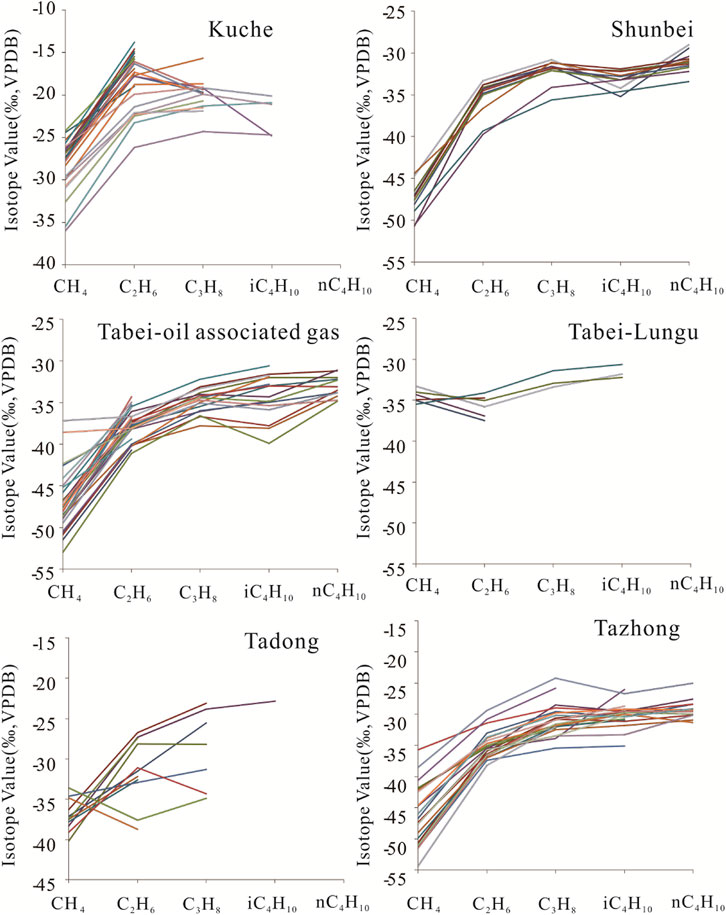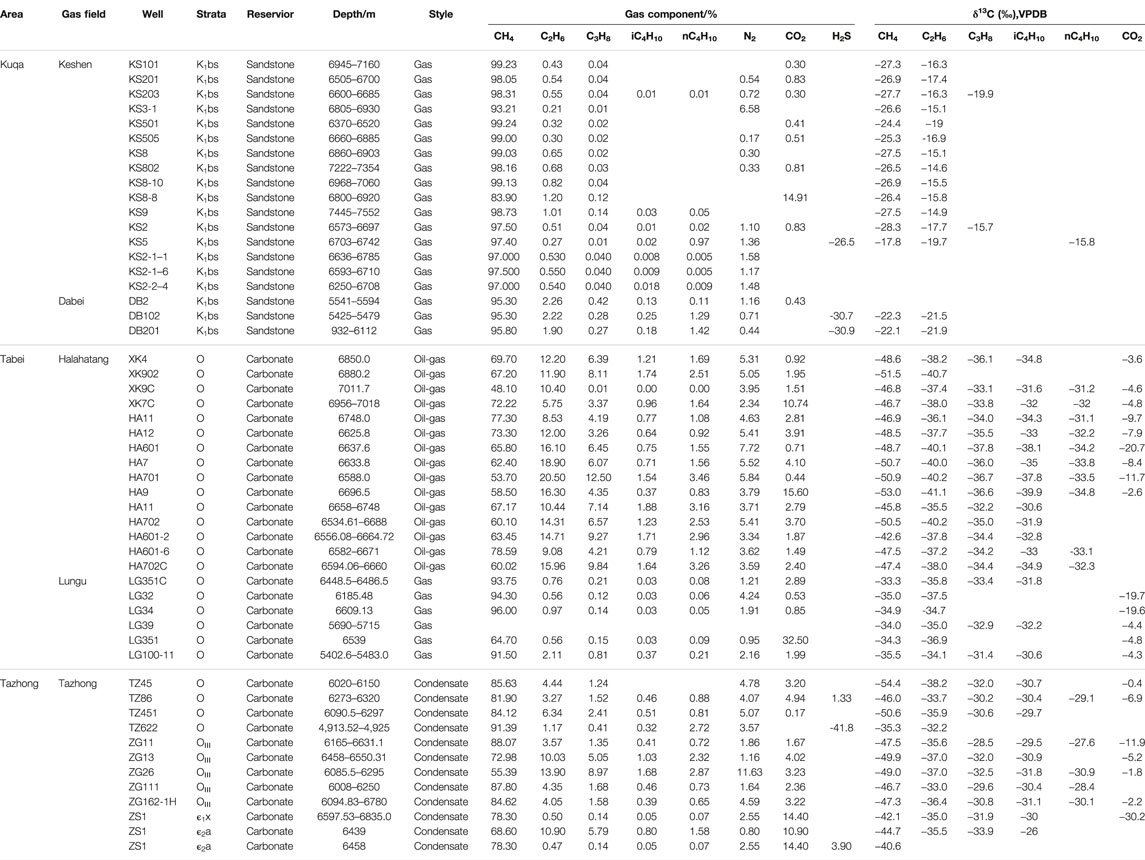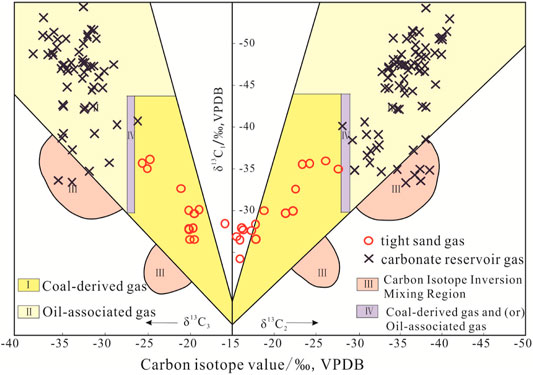- Research Institute of Petroleum Exploration and Development, Petrochina, Beijing, China
This research analyzed the composition and hydrocarbon isotope geochemical characteristics of ultra-deep natural gas (buried deeper than 6000 m) in more than 130 wells in the Tarim Basin. Characteristics of the ultra-deep natural gas components in the Tarim Basin are as follows: natural gas in the Kuqa sandstone reservoir is developed as dry gas, with a high methane content (an average of 95.53%) and a low ethane content (an average of only 1.39%). The ultra-deep gas of the marine craton carbonate reservoirs in the North Tarim-Central Tarim-East Tarim area is developed as wet gas. It is mainly composed of methane ranging from 56.1% to 98.8%, with an average content of 76.36% and also contains a small amount of ethane amounting to 6.74%. CO2 and H2S contents of ultra-deep condensate gas in the Central Tarim area are high, with maximum values of 24.2% and 23.1%, respectively. Isotopic characteristics are as follows: δ13C1 values of Kuqa natural gas are distributed between −36‰ and −25.3‰, with an average of −28.2‰, δ13C2 values are distributed between −26.2‰ and −13.8‰, with an average of −18.3‰. Most gas samples in Kuqa area are developed with the reversal of carbon isotopic series as δ13C2 > δ13C3, and the δ13CCO2 values are distributed between −19.5‰ and −10.3‰. The δ13C1 values of ultra-deep gas in marine craton carbonate rocks are distributed between −54.4‰ and −33.3‰, with an average of −42.6‰. δ13C2 values are distributed between −41.1‰ and −29.4‰, with an average of −33.8‰, and δ13CCO2 values are distributed between −28.2‰–0.6‰. According to the identification chart, it can be seen that the ultra-deep gas in the sandstone reservoir of the Kuqa foreland is mainly coal-derived gas in the high over-mature stage, and the reversal of carbon isotopic series may be caused by the mixing of natural gas of the same type and different sources. The natural gas in carbonate reservoirs of marine craton is mainly oil-type gas with complex sources, including both kerogen cracking gas and oil cracking gas. CO2 can be formed by organic and inorganic genesis. Inorganic CO2 is most likely to be generated by the dissolution of carbonate rocks under acid formation water.
Introduction
In Central and Western China’s foreland areas, those strata ranging in depth from 4,000 to 6000 m are considered to be deep strata, while the strata with a depth of more than 6000 m are ultra-deep strata (Dai et al., 2018a). Ultra-deep strata in China are rich in oil and gas resources and are one of the most important development fields for China’s petroleum industry in the future. China’s onshore ultra-deep oil and gas resources are concentrated in “ultra-deep carbonate rocks,” “ultra-deep clastic rocks” and “ultra-deep volcanic rocks,” which are mainly found in the Tarim Basin, Sichuan Basin, Ordos Basin, Bohai Bay Basin, Songliao Basin and Junggar Basin. The Tarim Basin is underlain by ultra-deep clastic reservoirs and carbonate reservoirs. As a result, it is rich in ultra-deep gas resources accounting for 51% of the total gas resources in the entire basin (Yang, et al., 2019).
The Tarim Basin is a large superimposed basin with several Paleozoic-Cenozoic foreland areas superimposed on the margin of the Paleozoic craton basin. Tarim Basin is primarily developed with ultra-deep exploration fields in the foreland and marine craton areas of Kuqa region. The source rocks of the Kuqa petroleum system are mainly coal and lacustrine mudstone from Triassic and Jurassic, and the reservoirs are Jurassic-Quaternary sandstone and Paleogene dolomite. The source rocks of marine craton area are largely formed by mudstone and marl from Cambrian and Lower Ordovician, and the reservoirs are Lower Paleozoic carbonate (Liu, et al., 2020; Zhang, et al., 2021).
The Tarim Basin is mainly developed with typical ultra-deep large-scale oil and gas fields such as the Kelasu gas field in the Kuqa Depression, the Ordovician oil and gas field in Harahatang, and the North Tarim Uplift and large-scale Ordovician condensate gas field in Central Tarim (Figure 1). Natural gas is developed in different phases, such as gas-reservoir gas, associated gas and condensate gas. The sources of natural gas are complex, including coal-formed gas and oil-type gas. Oil-type gas can be divided into kerogen cracking gas and oil cracking gas (Huang, et al., 2016; Chen et al., 2018; Liu et al., 2019; Zhu et al., 2019). It is a natural geological reservoir for studying the geochemical characteristics of ultra-deep natural gas and identifying gas sources. In consideration of the general diversity of composition and hydrocarbon isotope characteristics in the ultra-deep gas of Tarim Basin and the difficulty of gas source identification, more than 130 natural gas samples were collected in this research, including gas samples from the Cretaceous sandstone reservoirs of Keshen, Zhongqiu, Wushi, Bozi and Dabei in Kuqa foreland area, carbonate reservoirs of Harahatang, Lungu, Yingmaili and Luntai of marine craton area, Shunnan and Gucheng in East Tarim, and Ordovician reservoirs in Shunbei. According to the composition and hydrocarbon isotope of natural gas, the geochemical characteristics of sandstone gas in the foreland area and carbonate gas in craton area of Kuqa are compared, and alkane gas and CO2 gas sources are identified. The comparison of the geochemical characteristics of natural gas in the Kuqa foreland area and the marine craton area is not only a deeper analysis of different oil and gas systems in Tarim, but also a deepening of the theory of ultra-deep natural gas source identification.
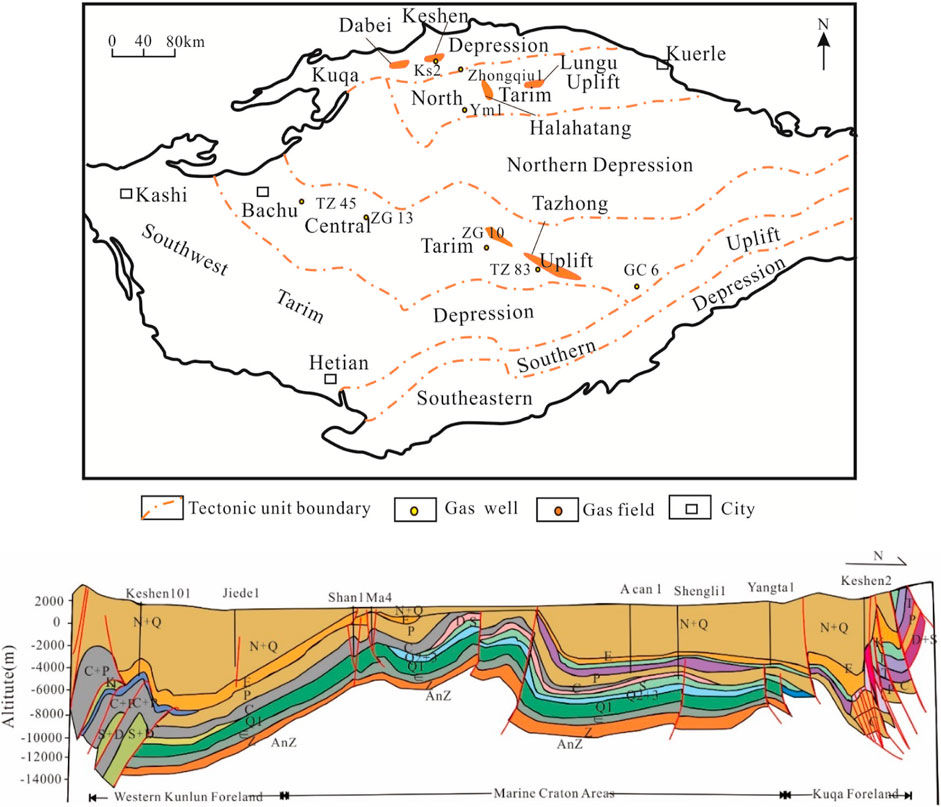
FIGURE 1. Structural distribution map of Tarim Basin (the second map is according to Yang et al., 2019).
Experimental Methods
Natural gas component analysis was carried out on HP6890 chromatograph, using SGE-60 chromatographic column (50 m×0.25 mm×0.25 mm), the inlet temperature was 300°C, the carrier gas was nitrogen, the flow rate was 1 ml/min, and the split ratio was 50:1. The temperature program was raised from 30°C to 260°C, and the heating rate was 3°C/min.
The carbon isotope determination of natural gas components was carried out on the DeltapluxXL gas chromatography-combustion interface-isotope mass spectrometer (GC/C/IRMS) produced by Thermo Fisher. The chromatographic column is 30 m×320 μm PLOT Q, and the carrier gas flow rate is 2 ml/min. The temperature of the oxidation furnace is 960°C, the temperature of the reduction furnace is 650°C, the electron bombardment ion source, the electron energy is 120 eV, and the accelerating voltage is 3 kV. The heating program was an initial temperature of 30°C, constant temperature for 5 min, then increased to 80°C at 8°C/min, and then increased to 260°C at 4°C/min. Carbon isotope values are compared to the GBW 04405 reference, giving values relative to PDB with a standard deviation of ±0.3‰.
The instrument used for hydrogen isotope detection of natural gas components is the same MAT253 gas chromatography-thermal conversion interface-isotope mass spectrometer produced by Thermo Fisher Company. The chromatographic column is 30 m×320 μm PLOT Q, and the carrier gas flow rate is 2 ml/min. The temperature of the pyrolysis furnace is 1,450°C, the electron bombardment ion source, the electron energy is 90 eV, and the accelerating voltage is 10 kV. The heating program was an initial temperature of 40°C, a constant temperature of 5 min, and then the temperature was increased to 80°C at 8°C/min, and then increased to 260°C at 4°C/min.
Results
Component Characteristics
After analyzing data from more than 130 wells, methane is absolutely dominant in the alkane gas of ultra-deep natural gas in Tarim Basin (Figure 2). Well Keshen 501, located in Keshen gas field of Kuqa, has highest methane content at 99.24%. 84% of the gas in Kuqa sandstone reservoir has a methane content of more than 95%. Well XK9C has the lowest methane content (48.1%). The natural gas in Well XK9C is associated gas generated from Halahatang carbonate rocks, North Tarim. The methane content of carbonate associated gas and condensate gas is less than 90% except for some gases of the Lungu, Shunnan and Gucheng gas reservoirs. The highest ethane content is 20.50% (Well HA701). The average ethane content of associated gas in Shunbei and North Tarim is relatively high, varying from 5.47% to 17.97%. The gas from the gas-reservoir in the East Tarim area has the lowest ethane content of only 0.11% (Well SN5). In addition, the ethane contents of natural gas in Kuqa, East Tarim and North Tarim reservoirs are relatively low. Well HA 701 has the highest propane content of 12.5%, and an average value of 2.68%. However, propane is not measured in some wells. Butane content in 23 wells is 0.
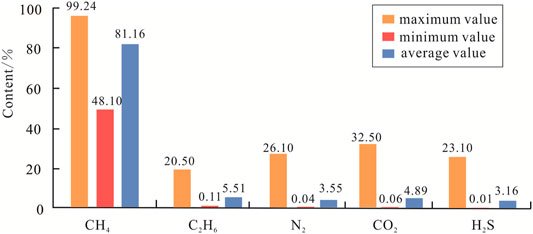
FIGURE 2. Natural gas components in deep layers of Tarim (In addition to this article, data sources include Wang et al., 2014; Zhu, et al., 2014; Zhu, et al., 2015; Dai, et al., 2016; Liu, et al., 2018; Zhu, et al., 2018; Ma et al., 2021; Wei, et al., 2019; Li, et al., 2020)
The non-hydrocarbon gas N2 content is the highest at 26.10% (Well YM2), the lowest content at 0.04% (well SN7), and has an average content of 3.55%. CO2 is developed with the highest content of 32.5% (Well LG351), the lowest content of 0.06% (Well GC12), and an average content of 4.89%. The average CO2 contents in Central and East Tarim are 6.98% and 9.11%, respectively. The lowest CO2 is developed in ultra-deep gas of Kuqa sandstone reservoir with an average of 1.2%. The H2S is developed with the highest content of 23.1% (Well ZG6), the lowest content of 0.01% (Well ZG5), and an average of 3.16%. The gas wells with highest H2S content are all located in the condensate gas area of Central Tarim.
As is shown in Figure 3, gas-reservoir gas is dominated by dry gas, with higher methane content than associated gas and condensate gas. Gas in the Cretaceous sandstone reservoir of the Kuqa foreland area is richer in methane than in the carbonate reservoir of marine craton in North and Central Tarim. The CO2 and H2S contents in ultra-deep condensate gas reservoirs of Central Tarim are high, with maximum values as high as 24.2% and 23.1%, respectively.
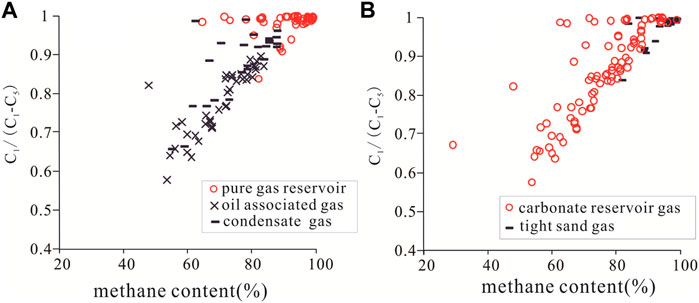
FIGURE 3. C1 (%)-C1/(C1-C5) of (A) natural gas in different states, (B) natural gas in different reservoirs of Tarim Basin.
Characteristics of Carbon and Hydrogen Isotopes
Carbon Isotopic Composition of Alkane Gas
As is shown in Figures 4, 5, Samples of the Cretaceous sandstone reservoir in the Kuqa foreland area were collected from Keshen (21 samples), Zhongqiu (1 sample), Wushi (3 samples), Bozi (3 samples) and Dabei (4 samples). The δ13C1 values are distributed between −36‰ and −25.3‰, with an average of −28.2‰, δ13C2 values are distributed between −26.2‰ and −13.8‰, with an average of −18.3‰. The reversal of carbon isotopic series as δ13C2 > δ13C3 occurs in most gas samples.
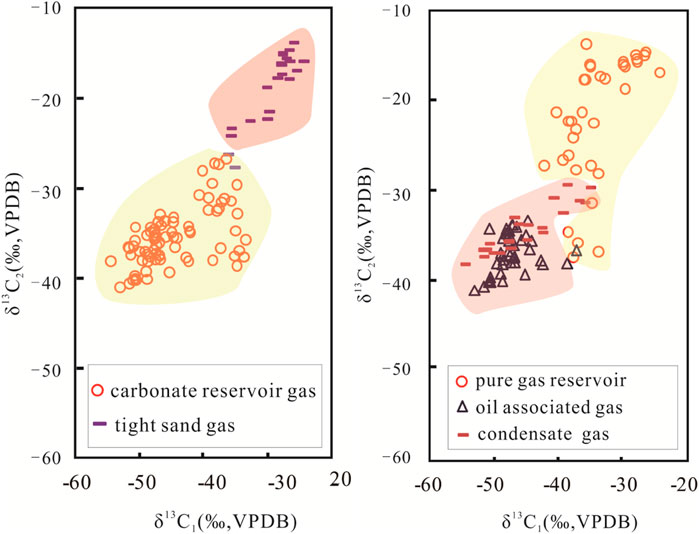
FIGURE 4. δ13C1-δ13C2 of deep natural gas in different states and in different reservoirs of Tarim Basin.
Gas samples from the ultra-deep gas reservoir in marine craton of North Tarim-Central Tarim-East Tarim include natural gas from Shunnan and Gucheng of East Tarim, Harahatang, Lungu, Yingmaili and Luntai of North Tarim, Ordovician-Cambrian in Central Tarim, and gas from the Shunbei Ordovician carbonate reservoir.
Natural gas in the Ordovician carbonate reservoirs of Harahatang, Yingmaili and Luntai in North Tarim are associated gas, with the δ13C1 value of −53‰ ∼ −45.2‰, and an average δ13C1 value of −48.3‰, with the δ13C2 value of −40.2‰∼−34.3‰, and an average δ13C2 value of −37.9‰. Some gas samples are developed with the reversal of carbon isotopic series as δ13C2 > δ13C3 or δ13C3 > δ13C4. Natural gas in the Lungu area is developed from gas reservoirs, with the δ13C1 value of −35.5‰ ∼ −33.3‰, an average δ13C1 value of −34.5‰, with the δ13C2 value of −37.5‰ ∼ −34.1‰, and an average δ13C2 value of −35.7‰. It is noteworthy that 4 of the 6 samples are formed with the reversal of carbon isotopic series as δ13C1 > δ13C2.
The ultra-deep gas of the Ordovician carbonate reservoir in Central Tarim is condensate gas, with the δ13C1 value of −54.4‰ ∼ −34.8‰, an average δ13C1 value of −45‰, with the δ13C2 value of −38.2‰ ∼ −29.7‰, and an average δ13C2 value of −34.5‰. Most gas samples are formed with the reversal of carbon isotopic series as δ13C3 > δ13C4.
Natural gas in the Ordovician carbonate reservoirs of Shunnan and Gucheng in East Tarim is from gas reservoirs, with the δ13C1 value of −40.2‰ ∼ −33.6‰, an average δ13C1 value of −36.9‰, with the δ13C2 value of −37.6‰ ∼ −26.7‰, and an average δ13C2 value of −31.6‰. The gas from East Tarim is similar to that in North Tarim, with the reversal of δ13C1 > δ13C2 and δ13C2 > δ13C3.
Ultra-deep natural gas in the Shunbei Ordovician reservoir is developed as associated gas, with the δ13C1 value of −50.7‰ ∼ −44.7‰, an average δ13C1 value of −47.6‰, the δ13C2 value of −39.7‰ ∼ −33.3‰ and an average δ13C2 value of −35.4‰. Most gas samples are formed with the positive carbon isotope series as δ13C1 < δ13C2 < δ13C3 < δ13C4.
In summary, the carbon isotope values of methane and ethane in the ultra-deep gas of the Kuqa sandstone reservoir are higher than those in the carbonate reservoir. Compared with gas-reservoir gas, the carbon isotope values of methane and ethane in associated gas and condensate gas are low.
Hydrogen Isotope Characteristics of Alkane Gas
Natural gas in the sandstone reservoir of Keshen, Kuqa is developed with the δ13D1 value of −155‰ ∼ −149‰, and the δ13D2 value of −105‰ ∼ −92‰. The δ13D1 values in the three gas samples of Shunnan carbonate gas reservoir in East Tarim are −134‰, −129‰ and −122‰, respectively. Condensate gas in Central Tarim is developed with the δ13D1 value of −-206‰ ∼ −162‰ and the δ13D2 value of −145‰ ∼ −103‰. The associated gas in North Tarim is developed with the δ13D1 value of −262‰ ∼ −153‰, and the δ13D2 value of −190‰ ∼ −143‰. It can be seen from Figure 6 that the distribution of hydrogen isotope values for methane is rather concentrated in the gas reservoirs of Keshen, Kuqa and Shunnan, East Tarim, whereas the distribution of hydrogen isotope values for other carbonate associated gas and condensate gas range widely.
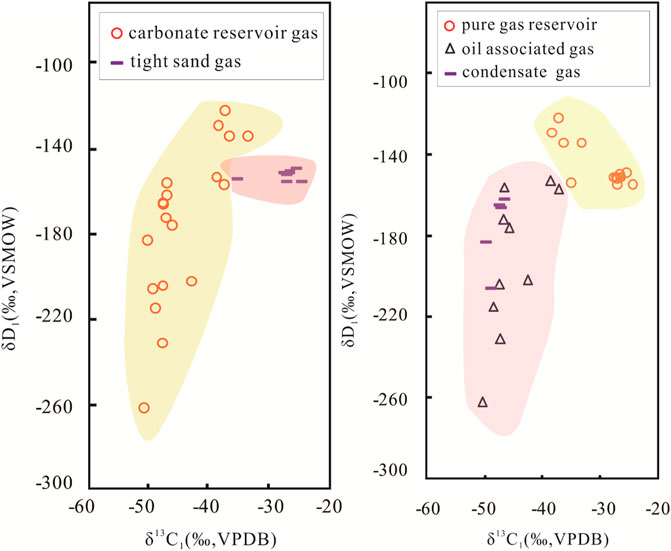
FIGURE 6. δ13C1-δD1 of deep natural gas in different states and in different reservoirs of Tarim Basin.
Carbon Isotopic Composition of CO2
It can be seen from Table 1 and other data from referces that the δ13CCO2 values of deep natural gas in Tarim Basin are distributed in −30.2‰–0.6‰ range, while those in China as a whole range between −39‰ and 7‰. As a result, the δ13CCO2 values of Tarim deep natural gas vary largely. The gas-reservoir gas in the sandstone reservoir of Keshen, Kuqa contains δ13CCO2 values of −19.5‰ ∼ −10.3‰, and an average value of −14.3‰, showing a centralized distribution, while the gas in carbonate reservoir has a wide distribution of δ13CCO2 values, such as the condensate gas in Central Tarim with the δ13CCO2 values from −30.2‰ to 0.6‰, showing the largest span in all regions.
Discussion
Alkane Gas Generation
Putting the data of Table 1 and other data from referces into the genetic identification chart of natural gas, it can be seen that the gas samples from the sandstone gas reservoir in the Kuqa foreland area are coal-derived gas, while the ultra-deep natural gas samples in the marine craton area of Central Tarim-East Tarim-North Tarim are oil-type gas zone (Figure 7). Natural gas in each zone will now be discussed separately.
Gas-reservoir gas in the sandstone reservoir of the Kuqa foreland area is mainly developed in Keshen-Dabei area. The gas fields and gas reservoirs in Keshen and Dabei are all located in the Kelasu structural belt of Kuqa, which belong to the Kelasu gas field. The gas reservoirs are developed as high pressure and ultra-high pressure reservoirs, with high formation temperature and pressure, while the pressure coefficient is between 1.60 and 1.86. The gas reservoirs belong to normal-temperature gas reservoirs with the temperature in the middle part of 146–188°C (Yang, et al., 2019; Li, et al., 2020). The carbon isotopes of methane and ethane show the natural gas belongs to coal-derived gas in the highover mature stage, and some of the gas is developed with the reversal as δ13C2 > δ13C3. The possible reasons for the reversal of carbon isotope series are: ① isotope fractionation effect during the process of natural gas migration; ② oxidation of alkane gas component by bacteria; ③ mixing of organic gas and inorganic gas; ④ mixing of coal-derived gas and oil-type gas; ⑤ mixing of natural gas of the same type and different sources, or gas of the same source and different periods; ⑥ reversal of alkane gas under high temperature and high pressure (Yu, et al., 2013; Dai, et al., 2016; Liu, et al., 2018). The Kuqa foreland area mainly develops thick coal-bearing source rocks and high-quality mudstone source rocks. A small amount of oil was generated in the early stage at a shallow depth, while a large amount of oil was generated in the late stage at a greater depth (Wei, et al., 2019; Wang, et al., 2021). As a result, the influence of ①∼④ can be eliminated. The most likely reason for reversal can be the mixing of natural gases of the same type (coal-derived gas) but from different sources. In addition, source rocks of the Keshen and Dabei gas fields have reached the over-mature stage. The gas reservoirs are under high pressure and high temperature, which may also cause the reversal of the ethane and propane carbon isotope series.
The deep natural gas in the marine craton of Central Tarim-East Tarim-North Tarim is developed as oil-type gas. Natural gas in marine craton is mainly composed of gas-reservoir gas, associated gas and condensate gas with diverse characteristics of components and hydrocarbon isotopes and complex sources. The Cambrian-Ordovician carbonate rocks in the marine craton can be divided vertically into upper, middle and lower oil and gas systems. The hydrocarbon-bearing layers in the upper oil and gas system are weathering crusts of the Lianglitage, Yijianfang, and Yingshan Formations of the Ordovician. The hydrocarbon-bearing layers in the middle oil and gas system are a deep Ordovician reservoir and Penglaiba Formation. And the hydrocarbon-bearing layers in the lower oil and gas system are Cambrian Xiaoerbulake Formation. At present, the upper system is highly explored and the main focus of this study (Yang, et al., 2019).
Previous studies argued that there are two types of gas sources in the marine craton area, one is the mature/high-mature wet gas from the Ordovician gas source, and the other is the over-mature dry gas from the Cambrian gas source. The high over-mature dry gas can be divided into kerogen cracking gas and oil cracking gas (Liu, et al., 2017; Dai et al., 2018b; Ni, et al., 2019; Ding, et al., 2020; Zhu, et al., 2020; Yan, et al., 2021; Zhao, et al., 2022). Now the natural gas will be discussed in each zone.
Central Tarim Area
Han et al. (2021) divided the condensate gas reservoirs in the Central Tarim Uplift of the Tarim Basin into primary gas and secondary gas reservoirs and believed that the primary condensate gas reservoirs in ultra-deep Lower Cambrian were mixed with kerogen cracking gas and oil cracking gas, which were mainly distributed across the eastern buried hill with few paleo-oil reservoirs, while the secondary Ordovician condensate gas reservoirs were mainly formed by the late-stage gas invasion and gas washing of paleo-oil reservoirs. Chen et al. (2018) believed that the Cambrian natural gas in Central Tarim was less affected by the late-stage filling of kerogen cracking gas, and was mainly composed of the early-stage oil cracking gas. According to Figures 8, 9, the Ordovician condensate gas in Central Tarim is distributed in the areas of kerogen cracking gas, oil cracking gas and the mixing zone, indicating the complex gas source, while the Cambrian condensate gas is mainly in the secondary cracking area of crude oil.
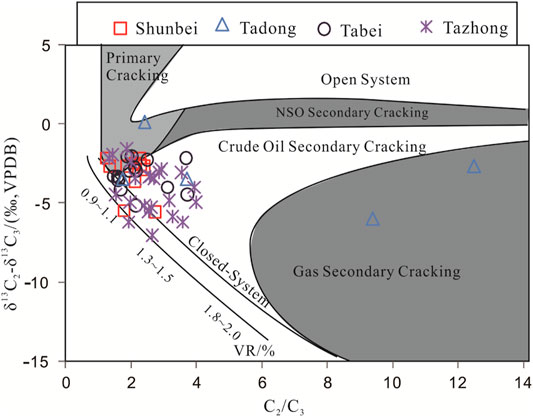
FIGURE 8. C2/C3-(δ13C2-δ13C3) of deep natural gas in Tarim. (base map according to Lorant et al., 1998)
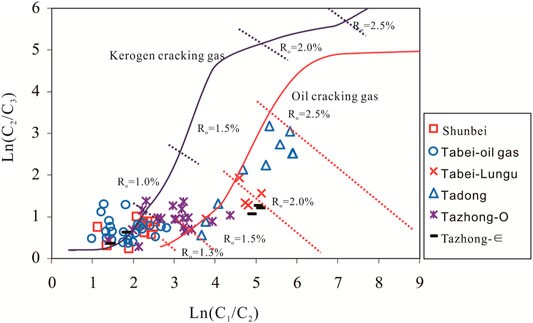
FIGURE 9. Ln (C1/C2)-Ln (C2/C3) of deep natural gas in Tarim. (base map according to Li, et al., 2017)
North Tarim Area
The methane content of Ordovician natural gas in the Halahatang area of North Tarim is fairly low among all the marine craton natural gas. The carbon isotope of methane is −53‰ ∼ −45.2‰, and the carbon isotope of ethane is −41.1‰ ∼ −34.3‰, which are also relatively low. Wu et al. (2016) and Zhu et al. (2019) believed that the Halahatang and Yingmai Ordovician natural gas in North Tarim is composed of both kerogen cracking gas and oil cracking gas, and comes mainly from Middle and Upper Ordovician source rocks in the Aman transition zone in the south of Harahatang. Figures 8, 9 show that the points of associated gas samples in North Tarim mainly fall into the area of kerogen cracking gas, and some samples fall into the area between kerogen cracking gas and oil cracking gas. The methane content of Ordovician natural gas in the Lungu gas field of North Tarim is basically higher than 90%, and the isotopes of methane and ethane are about −34‰ and −35‰, respectively, which are different from that in Harahatang gas. Previous studies believed that the Lungu oil and gas reservoir could be characterized as “dry gas and heavy oil” and developed as a modified oil and gas reservoir by gas invasion (Wu, et al., 2016). Figure 9 shows that the gas samples in the North Tarim gas reservoir are mainly located on the trend line of oil cracking gas, and the natural gas in the Lungu area is developed with the reversal of carbon isotope series as δ13C1 > δ13C2, which may be caused by the fractionation of carbon isotopes of methane and ethane during the interaction with crude oil during the gas invasion. This also shows that the source of natural gas in the Tarim marine craton is very complex, and the gas source analysis needs not only data on natural gas composition and isotopes, but also the actual geological conditions.
East Tarim Area
There are different views on the source of Ordovician natural gas in the Shunnan-Gucheng area of East Tarim. Wang et al. (2014) believed that the natural gas comes from Cambrian, Yun and Cao (2014) believed that the natural gas is mainly composed of kerogen cracking gas, while Zhou et al. (2019) believed that the natural gas is oil cracking gas. Based on the content of adamantane and thioadamantane, Ma et al. (2021) and Ma et al., 2021 believed that the Ordovician natural gas in the Shunnan-Gucheng area is oil cracking gas, and the cracking degree of oil can be 98%. Figures 8, 9 show that most gas samples in East Tarim are located in the area of oil cracking gas, indicating that the natural gas is mainly generated by oil cracking.
Shunbei Area
Wang et al., 2021 believed that the Ordovician natural gas in the Shunbei area is mainly kerogen cracking gas and is partly mixed with natural gas in the early stage of oil cracking. The gas-oil ratio of the Ordovician oil and gas reservoir in the Shunbei area is low, and the natural gas in this area is oil-associated gas. The oil has low content of methyladamantane, with a low cracking degree. The natural gas has similar maturity with oil, showing the same source from Cambrian source rocks. It is also mixed with a small amount of early-stage oil cracking gas. Figures 8, 9 show that the associated gas samples in Shunbei area mainly fall into the area of kerogen cracking gas area, and some fall into the middle part of kerogen and oil cracking gas, indicating the contribution of oil cracking gas.
Origin of CO2
CO2 origin identification is presented by effective index δ13CCO2. Dai et al., 2018a found that the δ13CCO2 value of organic CO2 is less than −10‰, while the δ13CCO2 value of inorganic CO2 is greater than −8‰. The carbon isotope value of inorganic CO2 generated from metamorphic carbonate rocks is close to the δ13CCO2 value of carbonate rocks, showing a difference of 0 ± 3‰. The δ13CCO2 values of inorganic CO2 generated from volcanic magma and mantle sources are mostly distributed in −6‰ ± 2‰ range. Based on the identification chart, it can be seen that two Kuqa sandstone gas and Central Cambrian gas samples show the characteristics of organic CO2, and most of the Ordovician natural gas in Halahatang, Shunbei and Central Tarim show the characteristics of inorganic CO2 (Figure 10). The He isotope content of Tarim deep gas is low and shows no characteristics of mantle-derived gas. The ground temperature of Halahatang is lower than 160°C and that of Shunbei area is lower than 180°C. As a result, it is difficult to decompose carbonate rocks. The CO2 is widely generated in deep gas of Tarim marine craton, and the CO2 content in Central Tarim is up to 24.2%. The dissolution of CO2 in water will make the formation water acidic, resulting in the dissolution of carbonate reservoirs and the production of CO2 with high δ13CCO2 value. Therefore, inorganic CO2 is most likely to be generated from the dissolution of carbonate rocks under the acidic formation water.
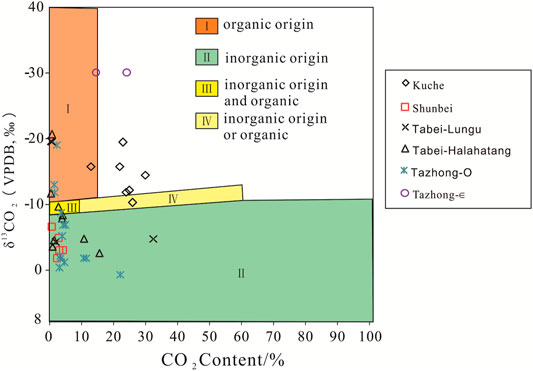
FIGURE 10. CO2 -δ13CCO2 of deep natural gas in Tarim. (base map according to Dai et al., 2018b).
Conclusion
Natural gas in the foreland ultra-deep reservoirs and marine craton carbonate reservoirs in Kuqa, of the Tarim Basin, have distinct geochemical properties. Natural gas in the Kuqa foreland area is coal-derived gas, generated from the Triassic and Jurassic. Oil and gas vertically migrated and accumulated into Cretaceous reservoirs along the fault network; the natural gas in the marine craton area is oil-type gas with complex sources. There is a need to combine the geochemical identification charts of natural gas in North Tarim, Central Tarim and East Tarim with the actual geological conditions to identify gas sources. Even in the same structural belt, the sources of gas-reservoir gas, associated gas and condensate gas may be different. Natural gas includes kerogen cracking gas, oil cracking gas and a mixture of the two. By comparing the different geochemical characteristics of the ultra-deep natural gas in the two oil-bearing systems, and combining the geochemical data with the actual geological conditions, we have a more comprehensive understanding of the ultra-deep natural gas in the Tarim in three-dimensional space, and also provide guidance for the further development of the Tarim Basin. Compared with other basins in China, natural gas and even crude oil have been continuously found in reservoirs deeper than 6000 m in the Tarim Basin due to the shallow burial in the early stage, rapid deep burial in the late stage and a low geothermal gradient. These allow the deep-buried source rocks in the Tarim Basin to continue to generate different kinds of hydrocarbons. Meanwhile, the structural evolution of the Tarim Basin is phased, resulting in a multi-stage evolution of source rocks and multi-stage oil cracking in craton marine area, leading to the complex origin of gas sources.
Data Availability Statement
The original contributions presented in the study are included in the article/Supplementary Material, further inquiries can be directed to the corresponding author.
Author Contributions
All authors listed have made a substantial, direct, and intellectual contribution to the work and approved it for publication.
Funding
This research was supported by the National Natural Science Foundation of China (41903062, 101019gj008001b24).
Conflict of Interest
CY, YN, JD, YH, CF, and FL were employed by Research Institute of Petroleum Exploration and Development, Petrochina.
Publisher’s Note
All claims expressed in this article are solely those of the authors and do not necessarily represent those of their affiliated organizations, or those of the publisher, the editors and the reviewers. Any product that may be evaluated in this article, or claim that may be made by its manufacturer, is not guaranteed or endorsed by the publisher.
References
Chen, F. R., Zhang, Y. J., Zhu, G. Y., and Zhang, B. S. (2018). Geochemistry and Accumulation Process of Deep Natural Gas in the Platform-Basin Region. Tarim. Basin. Natur. Gas. Geo. 29 (6), 880–891. doi:10.11764/j.issn.1672-1962.2018.05.022
Dai, J. X., Ni, Y. Y., Liu, Q. Y., Wu, X. Q., Gong, D. Y., Hong, F., et al. (2018b). Geochemical Characteristics of Natural Gas from Halahatang Sag in the TarimBasin. Chemicalica 43 (5), 477–488. doi:10.11698/PED.2018.04.05
Dai, J. X., Ni, Y. Y., Qin, S. F., Huang, S. P., Peng, W. L., and Han, W. X. (2018a). Geochemical Characteristics of Ultra-deep Natural Gas in the Sichuan Basin, SW China. Petr. Exp. And Dev. 45 (4). doi:10.1016/s1876-3804(18)30067-3
Dai, J. X., Ni, Y. Y., Zhang, W. Z., Huang, S. P., Gong, D. Y., Liu, D., et al. (2016). Relationships between Wetness and Maturity of Coal-Derived Gas in China. Petr. Exp. And Dev. 43 (5), 675–677. doi:10.11698/PED.2016.05.0110.1016/s1876-3804(16)30088-x
Ding, Z. W., Wang, R. J., Chen, F. F., Yang, J. P., Zhu, Z. Q., Yang, Z. M., et al. (2020). Origin, Hydrocarbon Accumulation and Oil-Gas Enrichment of Fault-Karst Carbonate Reservoirs: A Case Study of Ordovician Carbonate Reservoirs in South Tahe Area of HalahatangOilfield. Tarim Basin. Petr. Exp. And Dev. 47 (2). doi:10.1016/s1876-3804(20)60048-9
Han, J. F., Wu, G. H., Yang, H. J., Dai, L., and Su, Z. (2021). Type and Genesis of Condensate Gas Reservoir in the TazhongUplif of the Tarim Basin. Natru. Gas. Ind. 41 (7), 24–32. doi:10.3787/j.issn.1000-0976.2021.07.003
Huang, H., Zhang, S., and Su, J. (2016). Palaeozoic Oil-Source Correlation in the Tarim Basin, NW China: A Review. Org. Geochem. 94, 32–46. doi:10.1016/j.orggeochem.2016.01.008
Li, J., Li, J., Xie, Z. Y., Wang, C., Zhang, H. Z., Liu, M. C., et al. (2020). Oil and Gas Source and Accumulation of Zhongqiu 1 Trap in Qiulitage Structural Belt, Tarim Basin, NW China. Petr. Exp. And Dev. 47 (3). doi:10.1016/s1876-3804(20)60072-6
Li, J., Li, Z. S., Wang, X. B., Wang, D., Xie, Z., Li, J., et al. (2017). New Indexes and Charts for Genesis Identification of Multiple Natural Gases. Petrol. Explor. Dev. 44 (4), 503–512. doi:10.11698/PED.2017.040310.1016/s1876-3804(17)30062-9
Liu, G., Zeng, L., Zhu, R., Gong, L., Ostadhassan, M., and Mao, Z. (2021). Effective Fractures and Their Contribution to the Reservoirs in Deep Tight Sandstones in the Kuqa Depression, Tarim Basin, China. Mar. Petroleum Geol. 124, 104824. doi:10.1016/j.marpetgeo.2020.104824
Liu, Q., Jin, Z., Li, H., Wu, X., Tao, X., Zhu, D., et al. (2018). Geochemistry Characteristics and Genetic Types of Natural Gas in Central Part of the Tarim Basin, NW China. Mar. Petroleum Geol. 89, 91–105. doi:10.1016/j.marpetgeo.2017.05.002
Liu, Q., Jin, Z., Wang, X., Yi, J., Meng, Q., Wu, X., et al. (2018). Distinguishing Kerogen and Oil Cracked Shale Gas Using H, C-Isotopic Fractionation of Alkane Gases. Mar. Petroleum Geol. 91, 350–362. doi:10.1016/j.marpetgeo.2018.01.006
Liu, Q., Wu, X., Wang, X., Jin, Z., Zhu, D., Meng, Q., et al. (2019). Carbon and Hydrogen Isotopes of Methane, Ethane, and Propane: A Review of Genetic Identification of Natural Gas. Earth-Science Rev. 190, 247–272. doi:10.1016/j.earscirev.2018.11.017
Lorant, F., Prinzhofer, A., Behar, F., and Huc, A.-Y. (1998). Carbon Isotopic and Molecular Constraints on the Formation and the Expulsion of Thermogenic Hydrocarbon Gases. Chem. Geol. 147, 249–264. doi:10.1016/s0009-2541(98)00017-5
Ma, A. L., He, Y. L., Yun, L., Wu, X., Qiu, N., Chang, J., et al. (2021). The Geochemical Characteristics and Origin of Ordovician Ultra-deep Natural Gas in the North Shuntuoguole Area, Tarim Basin, NW China. Natru. Gas. Geo. 32 (7), 1047–1060. doi:10.1016/j.jnggs.2021.09.004
Ni, Y. Y., Liao, F. R., Gong, D. Y., Jiao, L. X., Gao, J. L., and Yao, L. M. (2019). Stable Carbon and Hydrogen Isotopic Characteristics of Natural Gas from Taibei Sag, Turpan-Hami Basin, NW China. Petr. Exp. And Dev. 46 (3). doi:10.1016/s1876-3804(19)60033-9
Wang, T. G., Song, D. F., Li, M. J., and Yang, C. (2014). Natural Gas Source and Deep Gas Exploration Potential of the Ordovician Yingshan Formation in the Shunnan-Gucheng Region, Tarim Basin. Oil Gas Geol. 35 (6), 753–762. doi:10.11743/ogg20140602
Wang, Z., Lv, X. X., Li, Y., Liang, H. T., Li, L., and He, T. (2021). Natural Fracture Opening Preservation and Reactivation in Deep Sandstones of the Kuqa Foreland Thrust Belt, Tarim Basin. Mar. Petroleum Geol. 127, 104956. doi:10.1016/j.marpetgeo.2021.104956
Wei, Q., Li, X., Liang, W. Q., Sun, K. X., Xie, Z. Y., Li, J., et al. (2019). Geochemical Characteristics and Genesis of Deep Tight Sandstone Gas in the Dabei-Keshen Zone, Kuqa Depression. Bull. Min., Petr. And Geo. 38 (2), 418–427. doi:10.19658/j.issn.1007-2802.2019.38.044
Wu, X., Han, J., Zhu, Y. F., and Liu, J. F. (2016). Analysis of Main Controlling Factors for Hydrocarbon Phases and Sturation in Eastern Lungu Area, Tarim Basin. Nat. Gas. Geo. 27 (1), 30–40. doi:10.11764/j.issn.1672-1926.2016.01.0030
Yan, L., Zhu, G. Y., Wang, S., Chen, Z. Y., Zhu, Y. F., Yang, M., et al. (2021). Accmulation Conditions and Favorable Areas for Natural Gas Accumulation in the 10000 Meters Ultra-deep Sinian-Cambrian in Tarim Basin. ACTAPETR. Sin. 42 (11), 1446–1457. doi:10.7623/syxb20211004
Yang, X. W., Wang, Z. M., He, W. Y., and Tian, J. (2019). Practice and Innovation of Ultra-deep Oil and Gas Exploration in Tarim Basin. Beijing: Petroleum Industry Press.
Yu, C., Huang, S. P., Gong, D. Y., Liao, F. R., Li, J., and Sun, Q. W. (2013). Partial Reversal Cause of Carbon and Hydrogen Isotope Compositions of Natural Gas: a Case Study in Sulige Gas Field, Ordos Basin. ACTA PET. SIN. 34 (1), 92–101. doi:10.7623/syxb2013S1011
Yun, L., and Cao, Z. C. (2014). Hydrocarbon Enrichment Pattern and Exploration Potential of the Ordovician in Shunnan Area, Tarim Basin. Oil Gas Geol. 35 (6), 788–797. doi:10.11743/ogg20140606
Zhang, Z. Y., Lin, C. S., Liu, Y. F., Liu, J. Y., Zhao, H. T., Li, H., et al. (2021). Lacustrine to Fluvial Depositional Systems: The Depositional Evolution of an Intracontinental Depression and Controlling Factors, Lower Cretaceous, Northern Tarim Basin, Northwest China. Mar. Petro. Geo. 126. doi:10.1016/j.marpetgeo.2021.104904
Zhao, X. X., Li, B., and Wu, G. H. (2022). Genesis and Enrichment Model of Ordovician Multi-phase Oil and Gas Reservoirs in Tazhong Block. Tarim. Basin. Natru. Gas. Geo. 33 (1), 36–48. doi:10.11764/j.jssn.1672-1926.2021.07.004
Zhou, X., Lü, X., Zhu, G., Cao, Y., Yan, L., and Zhang, Z. (2019). Origin and Formation of Deep and Superdeep Strata Gas from Gucheng-Shunnan Block of the Tarim Basin, NW China. J. Petroleum Sci. Eng. 177, 361–373. doi:10.1016/j.petrol.2019.02.059
Zhu, G., Li, J., Zhang, Z., Wang, M., Xue, N., He, T., et al. (2020). Stability and Cracking Threshold Depth of Crude Oil in 8000 M Ultra-deep Reservoir in the Tarim Basin. Fuel 282, 118777. doi:10.1016/j.fuel.2020.118777
Zhu, G., Milkov, A. V., Zhang, Z., Sun, C., Zhou, X., Chen, F., et al. (2019). Formation and Preservation of a Giant Petroleum Accumulation in Superdeep Carbonate Reservoirs in the Southern Halahatang Oil Field Area, Tarim Basin, China. Bulletin 103 (7), 1703–1743. doi:10.1306/11211817132
Zhu, G., Weng, N., Wang, H., Yang, H., Zhang, S., Su, J., et al. (2015). Origin of Diamondoid and Sulphur Compounds in the Tazhong Ordovician Condensate, Tarim Basin, China: Implications for Hydrocarbon Exploration in Deep-Buried Strata. Mar. Petroleum Geol. 62, 14–27. doi:10.1016/j.marpetgeo.2015.01.002
Zhu, G., Zhang, B., Yang, H., Su, J., and Han, J. (2014). Origin of Deep Strata Gas of Tazhong in Tarim Basin, China. Org. Geochem. 74, 85–97. doi:10.1016/j.orggeochem.2014.03.003
Keywords: natural gas isotope, gas source, carbon dioxide, kerogen cracking gas, oil cracking gas
Citation: Yu C, Ni Y, Dai J, He Y, Fang C and Liao F (2022) A Comparison of the Geochemical Characteristics of Ultra-Deep Natural Gas in the Kuqa Foreland and Marine Craton Areas in the Tarim Basin, China. Front. Earth Sci. 10:884445. doi: 10.3389/feart.2022.884445
Received: 26 February 2022; Accepted: 31 May 2022;
Published: 22 June 2022.
Edited by:
Jon Hawkings, University of Pennsylvania, United StatesReviewed by:
Dongya Zhu, SINOPEC Petroleum Exploration and Production Research Institute, ChinaShuai Yin, Xi’an Shiyou University, China
Copyright © 2022 Yu, Ni, Dai, He, Fang and Liao. This is an open-access article distributed under the terms of the Creative Commons Attribution License (CC BY). The use, distribution or reproduction in other forums is permitted, provided the original author(s) and the copyright owner(s) are credited and that the original publication in this journal is cited, in accordance with accepted academic practice. No use, distribution or reproduction is permitted which does not comply with these terms.
*Correspondence: Yunyan Ni, bml5eUBwZXRyb2NoaW5hLmNvbS5jbg==; Jinxing Dai, ZGp4QHBldHJvY2hpbmEuY29tLmNu
 Cong Yu
Cong Yu Yunyan Ni
Yunyan Ni Jinxing Dai*
Jinxing Dai* Chenchen Fang
Chenchen Fang Fengrong Liao
Fengrong Liao